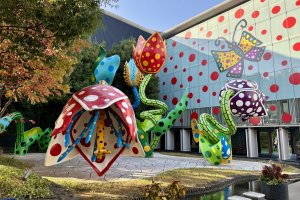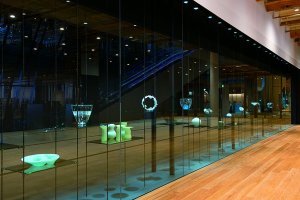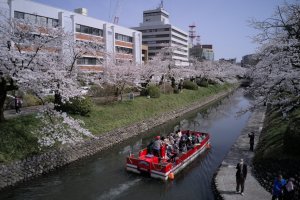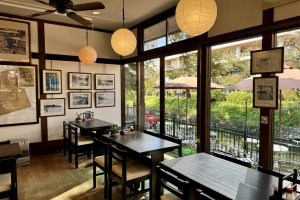Are you looking for natural beauty, delicious cuisine, thought-provoking art, and cultural heritage to enhance your Japan itinerary? If so, Buri Kaido is the perfect route for you.
Wait—what is Buri Kaido? We are glad you asked!
Buri Kaido is a route that once connected Toyama, Hida, Takayama, and present day Matsumoto for the purpose of transporting buri, or yellowtail. While Buri Kaido is no longer in operation, its phantom route inspired us to explore these four cities more deeply. In our exploration, we discovered a variety of tourist-favorites and hidden gems that are guaranteed to enrich your trip to Japan. Let’s go through them together!
Toyama City
Toyama City, which occupies almost the entire central to southeastern part of Toyama Prefecture, served as the starting point for Buri Kaido since fishermen caught yellowtail in Toyama Bay. Today, this vibrant metropolitan area is popular for its thriving art culture, preserved history, and views of the distant Tateyama Mountains.
Toyama Glass Art Museum

One of the city’s most popular destinations is the Toyama Glass Art Museum. This contemporary art museum is situated in the heart of Toyama City and displays glass sculptures and installations from artists around the globe. The building itself is a work of art and was designed by world-renowned architect Kengo Kuma. The eye-catching facade—composed of granite, glass, and aluminum panels—wonderfully complements the interior’s spacious and predominantly wooden design. The museum is located in TOYAMA KIRARI, which is a composite facility also home to the Toyama City Public Library Main Building.

The facility has six floors with four exhibition rooms and two galleries. The sixth floor is home to the “Glass Art Garden,” which features artwork from contemporary glass artist Dale Chihuly. The colorful and uniquely-shaped sculptures are hypnotizing and transport visitors to seemingly alien worlds. Do not miss the “Glass Art Passage” as well, located on the second, third, and fourth floors, as its works are exclusively from artists associated with Toyama.
The entire facility exudes a sense of refinement, while still retaining a warm and inquisitive environment—making it an excellent place to peacefully wander and simply enjoy the diversity of artists’ creativity. Since the museum changes its displayed works periodically and hosts special exhibitions, repeat visits are ideal!
Aside from art displays, the facility also has a museum shop, a cafe, and a library area where you can further dive into the world of art. English floor guides are available on the first floor.
Details:
- Address: 5-1 Nishicho, Toyama City, Toyama 930-0062 (Google Map)
- Website: https://toyama-glass-art-museum.jp/en/
Matsu River Cruises and Matsukawa Riverside Cafe

Matsu River flows through the center of Toyama City and is a relaxing place for residents and visitors alike to enjoy nature in an urban setting. The 2.5km long river is lined with around 500 cherry trees and is recognized as one of Japan’s top 100 cherry blossom spots—making it extremely popular during spring. During this magical time, you can enjoy the blossoms along a promenade that flanks the river or from the water with a Matsu River Cruise (our recommendation)! Along the gentle waters, you can admire pastel petals against the encircling highrises—painting a beautiful picture of spring in Japan’s cities.
Important notice:
The Matsu River Cruise has been suspended since July 31, 2024 due to restoration work on the Matsu River and will reopen on March 20, 2025. Reservations for spring 2025 are available. The Matsukawa Riverside Cafe is open. Please review the calendar for details about the cafe’s schedule.
While spring is the area’s most popular time of year, you can also enjoy the river cruise during the thriving greenery of summer or the golden hues of autumn. The boat is not in operation during winter.

Before or after your boating experience, stop by Matsukawa Riverside Cafe, directly next to the boarding area, to enjoy a sweet treat and fun wagashi-making experience! Wagashi are artfully-crafted, traditional Japanese sweets. For just ¥730 (¥1,200 with the inclusion of matcha), the cafe will provide you a kit with all the necessary ingredients and instructions. Your job is to assemble.

The available kits vary depending on the month, and reflect the time of year. The kits come with illustrated guidelines and even have QR codes that connect you to helpful instructional videos! The meticulous process is fun, and yields a cute, handmade treat that you can enjoy from seats overlooking the river. Please note that the kits take 30 minutes to defrost, so be sure to reserve one ahead of time. While it is thawing, why not purchase another one of the cafe’s tasty treats? We recommend the Toyama Castle matcha parfait! For more information about the experience fee, please contact the facility. Details are in the website below.
Details:
- Address: 1-34 Honmaru, Toyama City, Toyama 930-0081 (Google Map)
- Website: https://matsukawa-cruise.jp/en/
View of the Tateyama Mountains from Toyama City Hall

Rising southeast of Toyama City’s metropolitan area, the Tateyama Mountains stand as an impressive and beloved sight. One of the best places to view this mountain range is from Toyama City Hall’s FREE observation deck.
At 70 meters tall, the observatory offers expansive, 360° views of Toyama’s cityscape and encircling nature. Of course, the Tateyama Mountains are the observatory’s most popular view. The staggered collection of snow-tinged peaks rise and fall in a majestic fashion, making the Toyama City’s skyscrapers appear tiny in comparison. The clearest time to view the mountains is from November to February. Apart from the Tateyama Mountains, the observatory also affords views of Jinzu River to the west and even the aforementioned Matsu River! On a clear day, the blue skies, vast urban landscape, and natural beauty make for mesmerizing visuals.
Details:
- Address: 7-38 Shinsakuramachi, Toyama City, Toyama 930-0005 (Google Map)
- Website: https://www.city.toyama.lg.jp/shisei/profile/1010702/1013545/index.html
Hida City
Hida City is a quaint area situated in northern Gifu Prefecture and was the second stop along Buri Kaido. This picturesque townscape is largely untouched by tourism and is characterized by its traditional buildings, carp-filled canals, surrounding mountains, and homey vibes. The setting will immediately put your mind at ease with its tranquil ambience, making it an ideal place to enjoy a slower pace of travel.
Ohbora Kimono Shop

Immerse yourself in Hida-Furukawa’s charming atmosphere with a stop at Ohbora Kimono Shop. This inviting establishment, run by an equally endearing woman, sells local textiles and crafts, including the area’s beloved braided cords, and even offers braided bracelet and keychain workshops for hands-on experiences. The resulting souvenir is a lovely way to immortalize your Hida City memories.

As the name suggests, the shop also has kimono rentals! With help from the staffs’ experienced eyes, choose your favorite garment and accessories, and then explore Hida City’s time-frozen alleyways in appropriate fashion. Every part of the city makes for picture-perfect photos.
The staff speak English and are incredibly friendly, encapsulating the warmth and hospitality of Hida City.
Details:
- Address: 2-15 Furukawacho Honmachi, Hida City, Gifu Prefecture 509-4232 (Google Map)
- Website: https://hida.travel/destination/ohbora-kimono-shop/84#
Hida Beef at Okadaya and Hida Croquette Shop

One of Hida’s most prized culinary delicacies is Hida beef. This high-quality, sub-brand of wagyu is known for its signature marbling, melt-in-your-mouth tenderness, and exquisite flavor. If you are interested in trying this gourmet meat without breaking the bank, we recommend Okadaya, a combined souvenir shop and food stall. The establishment’s traditional wooden exterior and tantalizing aromas are guaranteed to draw you in.

Okadaya’s simple, yet expertly-executed menu includes Hida beef skewers grilled in an addicting sauce, midarashi-dango (skewered rice dumplings coated in a sweet soy sauce glaze), and gohei-mochi (grilled sticky rice served on a stick). Incredibly, the Hida beef skewers are only 380 yen! The skewers are delicious in all seasons, but are especially comforting in the colder months since the shop freshly grills them and serves them warm. After enjoying the nourishing snacks, be sure to check out Okadaya’s souvenir shop, which is home to a variety of Hida-themed treats and souvenirs.
Details:
- Address: 12-34 Furukawacho Ichinomachi, Hida City, Gifu Prefecture 509-4234 (Google Map)
- Website: https://hida.travel/destination/okadaya/107#

Continue your Hida Beef journey at Hida Croquette Shop! Beloved by locals and tourists alike, this eatery serves meat and potato croquettes crafted with savory Hida Beef and potatoes grown in Hida and Hokkaido.

The shop freshly fries its croquettes with each order, resulting in a flavorful snack that has the perfect balance of crispiness to softness. The hand-held bite will undeniably warm your foodie’s soul and body!
Details:
- Address: 10-1 Furukawacho Ichinomachi, Hida City, Gifu Prefecture 509-4234 (Google Map)
- Website: https://hida.travel/destination/hida-croquette-honpo/88
Rail Mountain Bike: Gattan Go

Thanks to its stunning mountains and lush forests, Hida City is more than just its quaint townscape and serves as a healing natural getaway. Explore Hida City’s outdoors like never before with a Rail Mountain Bike (Rail-MTB) Gattan Go experience! This unique attraction combines mountain biking and formerly used railway tracks to create immersive excursions across Hida City’s forests, bridges, rivers, and tunnels.

Rail-MTB Gattan Go has two options—the Town Course (60 minutes) and Canyon Course (75 minutes). Thanks to the electric mountain bike’s physical assistance, the Town Course is suitable for children starting at the age of one and the Canyon Course is fitting for people above elementary school age. Please note that priority is given to those who make reservations in advance.
The leisure exercise, coupled with the refreshing countryside air and enchanting views, makes for both a physically and mentally nourishing adventure.
Details:
- Address (Town Course): 1327-2 Azumo, Kamioka, Hida City, Gifu Prefecture 506-1147 (Google Map)
- Address (Canyon Course): Nishi-urushiyama, Kamioka, Hida City, Gifu Prefecture 506-1215 (Google Map)
- Website: https://rail-mtb.com/en/
Takayama City
Let’s continue our adventure along the fish transportation route to Takayama City, also located in Gifu Prefecture. This area shares the same natural beauty of Hida and is renowned for its preserved Edo Period (1603-1868) townscape. The city’s historic district is especially famous for its small alleyways lined with wooden merchant houses where visitors can both shop for local wares and enjoy sceneries of the past.
Hida Takayama Miyagawa Morning Market

Hida Takayama Miyagawa Morning Market is an excellent place to experience local life. This market opens every day from 7am (8am in winter) to 12pm and features about 20 locally-run stalls selling vegetables, fruits, processed food goods, crafts, snacks, and more. Despite the early hour, the market is full of activity, with residents buying groceries and tourists seeing Takayama wares. Directly adjacent to the market rests the Miyagawa River, which provides a visually and auditorily pleasing backdrop. There are a number of permanent stores located across from the market that sell souvenirs, foods, kitchenwares, and more.

If you are looking to pick up a craft that epitomizes Takayama, we recommend sarubobo. Sarubobo are traditional Japanese dolls that have long been used as protective amulets in Takayama. You will find this cute doll everywhere, especially in keychain form, so please make sure to buy one up to protect you during your travels.
Details:
- Address: Shimosannomachi, Takayama City, Gifu 506-0841 (Google Map)
- Website: https://www.asaichi.net/language/english
Hirase Sake Brewery Tour

Thanks to its pristine water and ideal brewing environment, Takayama has been a city of sake for a long time. In the late seventeenth century, the city was home to 56 sake breweries! Today, only seven facilities remain and Hirase Sake Brewery reigns as the oldest and largest one. This sake brewery is a 15th generation business with over 400 years of history and follows traditional methods to craft its high-quality products.
Immerse yourself in these age-old customs with a brewery tour hosted by Happy Plus Corp—a local tour company that aims to share Takayama’s charm with visitors. Your English-speaking guide will first provide a quick overview of Takayama’s history in the sake industry, before leading you to Hirase Sake Brewery. The establishment’s historic facade, which is about 100 years old, instantly transports you to the past.

The tour guide will bring you through the inner workings of the facility where you can see bottling machinery and massive sake brewing tanks. As you explore, your guide will explain the types of rice used for sake making, as well as the brewing process. Finally, you can try some of the brewery’s delicious products. While tasting the varieties of sake, the tour guide provides you with information about their differences. The entire experience is both enlightening and enjoyable. Please note that you cannot book tours directly at the brewery, but must visit Happy Plus Corp’s office, located only about a two-minute walk from the brewery.
Details:
- Brewery address: 82 Kami-Ichinomachi, Takayama City, Gifu Prefecture 506-0844 (Google Map)
- Brewery website: https://kusudama.ocnk.net/home
- Happy Plus Corp address: 22 Kamininomachi, Takayama City, Gifu Prefecture, Japan 506-0845 (Google Map)
- Happy Plus Corp website: https://happy-plus.co.jp/en/tours/sake-brewery-tour/
Hirayu Waterfall

To take a closer look at Takayama’s stunning nature, let’s travel beyond the city’s borders to Hirayu Waterfall. This impressive waterfall is 64 meters high and nestled in the Japanese Alps. It has been selected as one of the 100 best waterfalls in Japan. The surrounding rocky cliffs and beautiful forest scenery make the waterfall a sight worth seeing in all seasons. In spring and summer, you can enjoy the brilliant greenery of new leaves, and in autumn you can admire dazzling shades of yellow, orange, and red against the roaring waters. Winter is arguably the falls’ most magical time of year, when the waterfall completely freezes over and the landscape receives a healthy layer of snow. This wintertime sight is captivating in itself and is further enhanced during the Hirayu Waterfall Ice Festival (February 15 to 25) when the city illuminates the sparkling scene at night.
Hirayu Waterfall is located in Hirayu Onsen, a quaint town filled with hot springs. We highly recommend stopping by one of the hot spring facilities to relax and further appreciate the mountain scenery. Of course, the naturally-blessed area is also a great place to enjoy camping and hiking!
Hirayu Waterfall is only a few minutes walk from a nearby parking lot via a flat, paved path.
Details:
- Address: Okuhida Onsen-go, Hirayu Onsen Takayama City, Gifu Prefecture 506-1433 (Google Map)
- Website: https://www.okuhida.or.jp/en/archives/1804
Matsumoto City
Buri Kaido’s final destination was Shinshu, or modern day Matsumoto City in Nagano Prefecture. While this lively metropolis is most famous for Matsumoto Castle, one of Japan’s most breathtaking, original castles, it is also home to a number of intriguing museums and serves as a popular gateway to the Japanese Alps.
Matsumoto City Museum of Art

Matsumoto City Museum of Art, perhaps the city’s most popular museum, is a cultural hub that aims to promote artists associated with the city, facilitate meaningful interactions between guests, and create an environment that supports and encourages future artists.
The museum’s most notable attraction is its permanent exhibition of Yayoi Kusama—an acclaimed avant-garde and Matsumoto-born artist. The museum’s entrance celebrates Kusama with its polka dot-embellished exterior (her signature style) and features whimsical tulip sculptures created by Kusama herself. The permanent exhibition, called “The Place for My Soul,” displays artwork from Kusama’s childhood to present day and guides visitors through her eventful life with thought-provoking and emotionally-charged paintings, installations, and sculptures. All of the descriptions are in both Japanese and English.

Apart from the Kusama exhibition, the museum also has an open gallery space, exhibition rooms that display artworks that rotate throughout the year—including alluring landscape paintings and calligraphy, a cafe, and a museum shop that sells Yayoi Kusama goods. The museum is a wonderful place to lose yourself in the expressive world of art.
Matsumoto City Museum of Art offers electronic tickets, which you can purchase here, as well as physical ones.
Details:
- Address: 4-2-22, Chuo, Matsumoto City, Nagano Prefecture 390-0811 (Google Map)
- Website: https://matsumoto-artmuse.jp/en/
Shirahone Onsen

Nestled in the wooded valleys of Chubu Sangaku National Park, Shirahone Onsen is a small hot spring village home to 11 ryokan, or traditional Japanese inns. The area’s milky-white hot springs are rich in minerals such as calcium and magnesium and have long been used by weary passersby—from samurai to local farmers to modern day hikers—for its health benefits. The nourishing waters, coupled with the nature-rich landscape of the Japanese Alps, epitomize relaxation.

To enjoy this slice of paradise, you can either opt for a day trip or overnight stay. For the full hot spring experience, we highly recommend the latter. At ryokan, you can access the hot springs day and night and are treated to exquisite Japanese cuisine, traditional lodging experiences, and of course, top notch Japanese hospitality. If you have a tight schedule, a day trip is also an excellent way to sneak in some well-deserved relaxation. A trip to Shirahone Onsen is a great way to take a break from your sightseeing-packed itinerary and experience the relaxing side of Japan.
Details:
- Address: Azumi, Matsumoto City, Nagano Prefecture 390-1520 (Google Map)
- Website: https://chubusangaku.jp/destinations/shirahone
Kamikochi

Kamikochi, which is also known as “the place where the gods descend,” truly looks like heaven on Earth. Located about 1,500 meters above sea level, this scenic highland rests along the Azusa River and is one of the most famous spots in the Chubu Sangaku National Park. From spring to autumn, visitors can admire transparent waters encircled by forests against grand peaks, which are dusted with winter’s lingering snow until the end of June. The view is one that must be seen to be believed.

Unsurprisingly, Kamikochi is a hotspot for outdoor enthusiasts and features a number of treks for beginner and advanced hikers. One of the most frequented trails extends from Kappa Bridge to Taisho Pond. This easy, 3.5 km path guides visitors through beautiful scenery—including views of Mount Yake and Mount Hotaka—and only takes about two hours round trip. From Kappa Bridge, you can also hike to the Myojin area (the opposite direction) for views of a shrine, Myojin Pond, and Myojin Bridge against verdant mountains. The right coast course takes about 70 minutes one-way, while the left coast course is shorter in time and distance at 45 minutes one-way. The courses are suitable for beginners, and visitors often use both courses to create a roundtrip hike.
You can use private cars or motorcycles to reach Sawando Bus Terminal. However, from this bus terminal, for preservation reasons, you can only reach Kamikochi via bus or taxi (about 25 minutes). You can also access Sawando Bus Terminal from Matsumoto Station with public transportation. If you intend to spend the night, the area is reasonably developed with multiple hotels and mountain lodges. Find your next natural retreat in Kamikochi’s godly landscapes.
Details:
- Address: Matsumoto City, Nagano Prefecture 390-1516 (Google Map)
- Website: https://www.kamikochi.org
Let Buri lead the way!
As outlined in detail above, Buri Kaido is more than just a past transportation route and acts as a surprisingly perfect map to guide you through some of Japan’s less touristy, yet equally intriguing, cities. From Toyama to Hida to Takayama to Matsumoto, explore rich worlds where art, natural beauty, and cultural heritage thrive.
Of course, this list is far from exhaustive and leaves plenty of hidden wonders for you to discover yourself.
So remember, follow the fish, and make unforgettable memories!



























